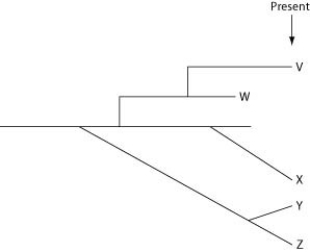Multiple Choice
The question refers to the following evolutionary tree, in which the horizontal axis represents time (present time is on the far right) , and the vertical axis represents morphological change.
Which conclusion can be drawn from this evolutionary tree?
A) A single clade (that is, a group of species that share a common ancestor) can include species that formed by gradualism and other species that formed by punctuated equilibrium.
B) A single clade (that is, a group of species that share a common ancestor) will either include species that formed by gradualism or species that formed by punctuated equilibrium.
C) Assuming that the tip of each line represents a species, there are five extant (that is, not extinct) species resulting from the earliest common ancestor.
D) Species X and Z best represent species that evolved by punctuated equilibrium.
Correct Answer:

Verified
Correct Answer:
Verified
Q4: House finches were found only in western
Q5: A small number of birds arrive on
Q6: How are two different species most likely
Q8: How is length of time for speciation
Q15: Two species of frogs belonging to the
Q38: Beetle pollinators of a particular plant are
Q40: In the oceans on either side of
Q45: Many songbirds breed in North America in
Q59: Use the following description to answer the
Q64: Which of these animals could overcome the